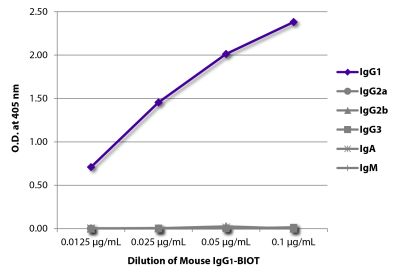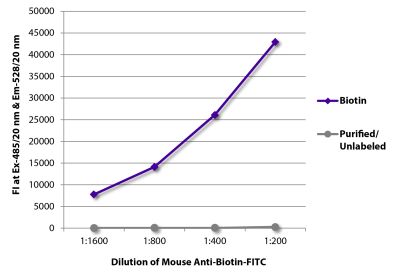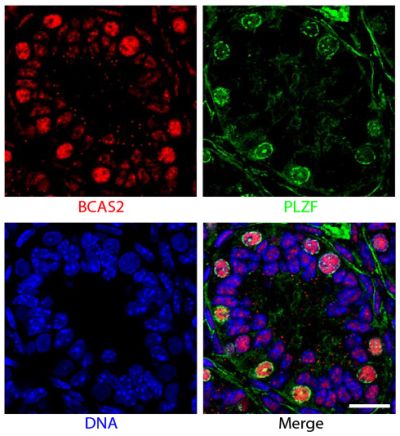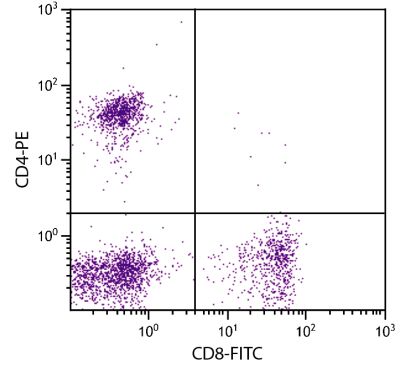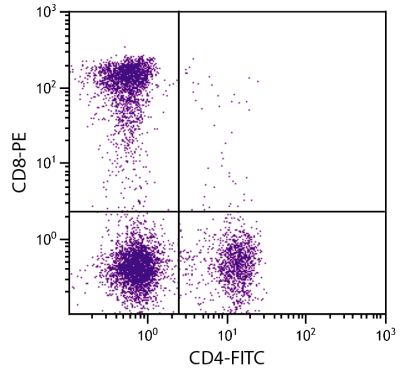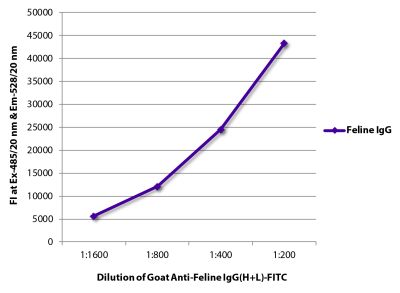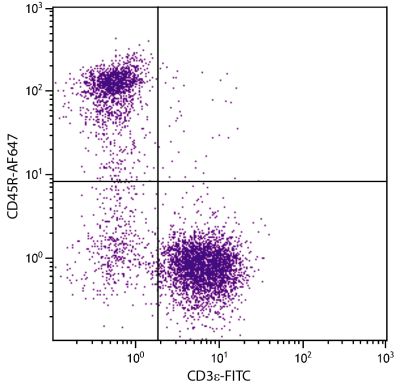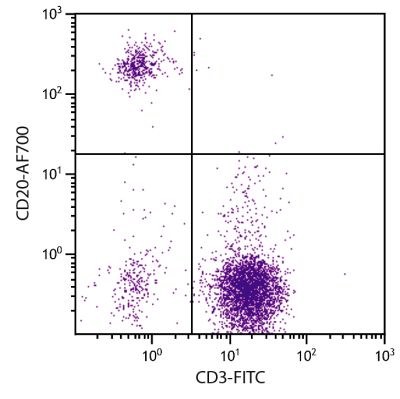Mouse Anti-Feline CD5-BIOT (f43)
Cat. No.:
8100-08
Biotin Anti-Feline CD5 antibody for use in flow cytometry, immunohistochemistry, ELISA, and immunoprecipitation assays.
$353.00
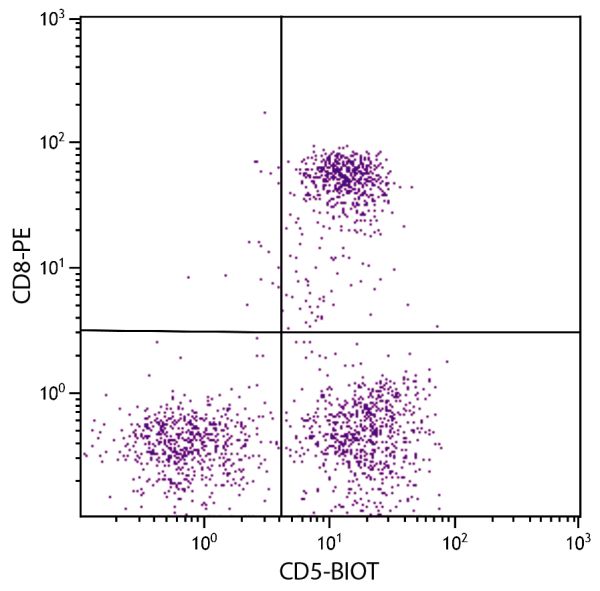

| Clone | f43 |
|---|---|
| Isotype | Mouse IgG1κ |
| Isotype Control | Mouse IgG1-BIOT (15H6) |
| Specificity | Feline/Lion CD5 |
| Alternative Names | fCD5, Pan T cell |
| Description | Feline CD5, a member of the scavenger receptor family of cell surface receptors, is a type I transmembrane glycoprotein that is expressed on most thymocytes and mature T lymphocytes. CD5 is thought to function in both cell-cell recognition and signal transduction. The monoclonal antibody f43 is useful as a pan T cell marker. |
| Immunogen | Feline T cells |
| Conjugate | BIOT (Biotin) |
| Buffer Formulation | Phosphate buffered saline containing < 0.1% sodium azide |
| Clonality | Monoclonal |
| Concentration | 0.5 mg/mL |
| Volume | 1.0 mL |
| Recommended Storage | 2-8°C |
| Applications |
Flow Cytometry – Quality tested 1,4-19 Immunohistochemistry-Frozen Sections – Reported in literature 2 Immunoprecipitation – Reported in literature 1 ELISA – Reported in literature 3 |
| RRID Number | AB_2796407 |
| Gene ID |
101083293 (Feline) |
| Gene ID Symbol |
CD5 (Feline) |
Documentation
Certificate of Analysis Lookup
Enter the Catalog Number and Lot Number for the Certificate of Analysis you wish to view
- 1. Ackley CD, Cooper MD. Characterization of a feline T-cell-specific monoclonal antibody reactive with a CD5-like molecule. Am J Vet Res. 1992;53:446-71. (Immunogen, FC, IP)
- 2. Fox JG, Perkins S, Yan L, Shen Z, Attardo L, Pappo J. Local immune response in Helicobacter pylori-infected cats and identification of H. pylori in saliva, gastric fluid and faeces. Immunology. 1996;88:400-6. (IHC-FS)
- 3. Bishop SA, Stokes CR, Gruffydd-Jones TJ, Whiting CV, Humphries JE, Osborne R, et al. Vaccination with fixed feline immunodeficiency virus (FIV) infected cells: protection, breakthrough and specificity of response. Vaccine. 1996;14:1243-50. (ELISA)
- 4. Shimojima M, Miyazawa T, Kohmoto M, Ikeda Y, Nishimura Y, Maeda K, et al. Expansion of CD8α+β- cells in cats infected with feline immunodeficiency virus. J Gen Virol. 1998;79:91-4. (FC)
- 5. Phipps AJ, Hayes KA, Buck WR, Podell M, Mathes LE. Neurophysiologic and immunologic abnormalities associated with feline immunodeficiency virus molecular clone FIV-PPR DNA inoculation. J Acquir Immune Defic Syndr. 2000;23:8-16. (FC)
- 6. Hokanson RM, TerWee J, Choi I, Coates J, Dean H, Reddy DN, et al. Dose response studies of acute feline immunodeficiency virus PPR strain infection in cats. Vet Microbiol. 2000;76:311-27. (FC)
- 7. Barr MC, Huitron-Resendiz S, Selway DR, Henriksen SJ, Phillips TR. Exogenous glucocorticoids alter parameters of early feline immunodeficiency virus infection. J Infect Dis. 2000;181:576-86. (FC)
- 8. Shimojima M, Nishimura Y, Miyazawa T, Kato K, Nakamura K, Izumiya Y, et al. A feline CD2 homologue interacts with human red blood cells. Immunology. 2002;105:360-6. (FC)
- 9. Hohdatsu T, Yamazaki A, Yamada M, Kusuhara H, Kaneshima T, Koyama H. Ability of CD8+ T cell anti-feline immunodeficiency virus activity correlated with peripheral CD4+ T cell counts and plasma viremia. Microbiol Immunol. 2003;47:765-73. (FC)
- 10. Howard KE, Fisher IL, Dean GA, Burkhard MJ. Methodology for isolation and phenotypic characterization of feline small intestinal leukocytes. J Immunol Methods. 2005;302:36-53. (FC)
- 11. Brennan G, Podell MD, Wack R, Kraft S, Troyer JL, Bielefeldt-Ohmann H, et al. Neurologic disease in captive lions (Panthera leo) with low-titer lion lentivirus infection. J Clin Microbiol. 2006;44:4345-52. (FC, Lion Reactivity)
- 12. Dean GA, LaVoy A, Yearley J, Stanton C. Cytokine modulation of the innate immune response in feline immunodeficiency virus-infected cats. J Infect Dis. 2006;193:1520-7. (FC)
- 13. Howard KE, Burkhard MJ. FIV infection induces unique changes in phenotype and cellularity in the medial iliac lymph node and intestinal IEL. AIDS Res Hum Retroviruses. 2007;23:720-8. (FC)
- 14. Pepin AC, Tandon R, Cattori V, Niederer E, Riond B, Willi B, et al. Cellular segregation of feline leukemia provirus and viral RNA in leukocyte subsets of long-term experimentally infected cats. Virus Res. 2007;127:9-16. (FC)
- 15. Mikkelsen SR, Reckling SK, Egan EA, Dean GA. In vivo depletion of CD4+CD25hi regulatory T cells is associated with improved antiviral responses in cats chronically infected with feline immunodeficiency virus. Virology. 2010;403:163-72. (FC)
- 16. Thompson J, MacMillan M, Boegler K, Wood C, Elder JH. Pathogenicity and rapid growth kinetics of feline immunodeficiency virus are linked to 3' elements. PLoS One. 2011;6(8):e24020. (FC)
- 17. Novacco M, Boretti FS, Franchini M, Riond B, Meli ML, Hofmann-Lehmann R. Protection from reinfection in "Candidatus Mycoplasma turicensis"-infected cats and characterization of the immune response. Vet Res. 2012;43:82. (FC)
- 18. Trzil JE, Masseau I, Webb TL, Chang C, Dodam JR, Cohn LA, et al. Long-term evaluation of mesenchymal stem cell therapy in a feline model of chronic allergic asthma. Clin Exp Allergy. 2014;44:1546-57. (FC)
- 19. Hicks CA, Willi B, Riond B, Novacco M, Meli ML, Stokes CR, et al. Protective Immunity against Infection with Mycoplasma haemofelis. Clin Vaccine Immunol. 2015;22:108-18. (FC)
See More


